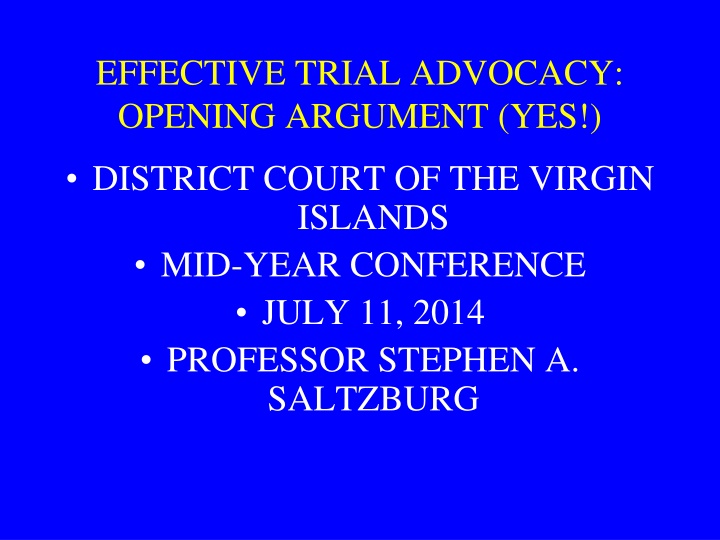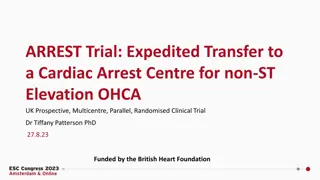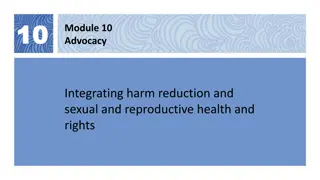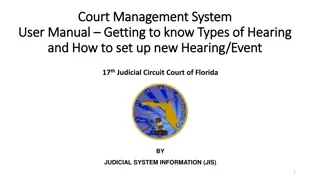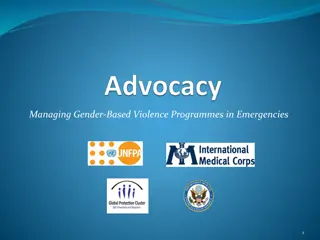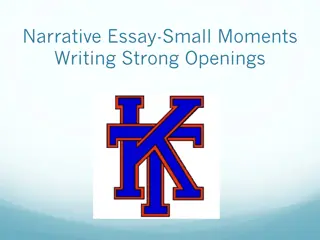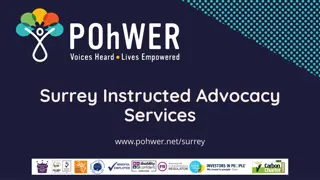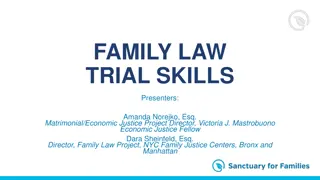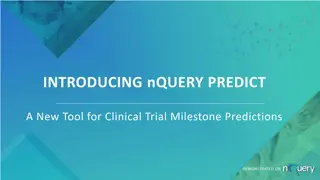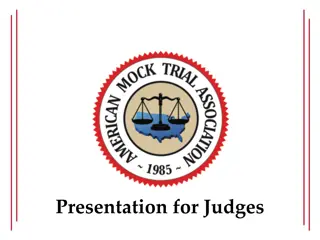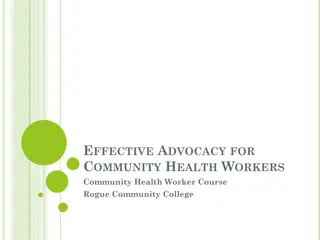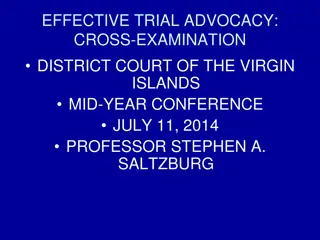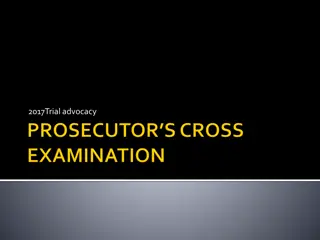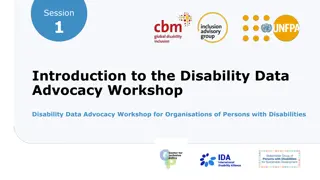- Effective Trial Advocacy: Strategies for Compelling Openings
Crafting a powerful opening statement in trial advocacy is crucial to persuading the jury and setting the tone for the case. This article emphasizes the importance of opening arguments, providing insights on how to structure and deliver them effectively. It discusses the significance of opening strong, avoiding waiver of openings, and the differences between openings and closings. Practical tips and expert advice from legal professionals are highlighted to help advocates master the art of compelling openings.
Download Presentation

Please find below an Image/Link to download the presentation.
The content on the website is provided AS IS for your information and personal use only. It may not be sold, licensed, or shared on other websites without obtaining consent from the author.If you encounter any issues during the download, it is possible that the publisher has removed the file from their server.
You are allowed to download the files provided on this website for personal or commercial use, subject to the condition that they are used lawfully. All files are the property of their respective owners.
The content on the website is provided AS IS for your information and personal use only. It may not be sold, licensed, or shared on other websites without obtaining consent from the author.
E N D
Presentation Transcript
EFFECTIVE TRIAL ADVOCACY: OPENING ARGUMENT (YES!) DISTRICT COURT OF THE VIRGIN ISLANDS MID-YEAR CONFERENCE JULY 11, 2014 PROFESSOR STEPHEN A. SALTZBURG
Opening Statement is An Argument It is an Argument and Judges Who Tried Cases Know This Nonetheless, Judges Expect that if They Ask, You Say Opening Statement is What We Expect to Prove and then Argue as Much as the Law Permits It is Not Argumentative We ll show you that the defendant acted like a vicious animal But it is powerful , I will prove to you that the defendant stood over the victim, John Jay, who lay unconscious on the ground, and the defendant took careful aim, considered carefully his actions, and shot Mr. Jay twice in the head with the premeditated intent to kill him. Does it sound like the defendant acted like a vicious animal? Yes, But You Did Not Say It
Openings are Harder than Closings You Open Before There is Any Evidence The Jury Has Nothing on Which to Make Up Its Mind But What You Say, How You Say it, and Whether You are Able to Bolster What You Say with Exhibits Openings are Intended to Persuade; To Turn a Neutral Juror Into a Committed Juror Closings are to Confirm
Open Strong No One Waits for Long to Begin to Make Up His/Her Mind Law Students are Evidence of This Drop/Add Right Now in this Room Students Are Deciding Whether They Like This Course Afterwards, Principles of Denial and Rationalization Kick In
Dont Waive Opening You Need to Open Strong If You Speak Second The Jurors Expect a Response If You Think that the Jurors Will Wait Until the Prosecutor or Plaintiff Finishes to Make Up Their Minds, You Will Open Too Late
Conn. Ct. App. Judge Douglas S. Lavine, The persuasive power of understatement, National Law Journal, August 30, 2010 Studies have shown that people form immediate, sometimes unconscious opinions about other people within seconds of meeting them. We size people up based on a wide array of factors how they look, what they wear, the way they walk and talk, what they say and how they say it, to name just a few.
Concerns No golden rule reference No statement of personal beliefs; vouching No references to inadmissible evidence No argument re applicable law May state legal contentions Careful; Opening may constitute legal admission and result in a directed verdict
Choice of Words I (or we) will prove The evidence will show There will be evidence to show There will evidence from which you can conclude There will be evidence from which, I submit, you can conclude
Words are Facilitators of Speech Say it Strongly You Have Nothing to Lose If You Say, The Evidence Will Show the Jurors Hear that as I Will Prove They are More Likely to Believe You Will Prove it if You Say it Strongly I
Three General Approaches Chronological Bad Not An Argument Witness by Witness Bad Not An Argument One Central Theme Only Way to Open
Nothing Can Stop You From Choosing The Most Persuasive Techniques You may combine story telling variations: chronological, parallel, reverse You should avoid witness by witness summaries Identify major elements and marshal details to support each, weave in witnesses, weave in less strong points Begin and end strong A clear theme lets you choose your organization
Prosecute Your Case All Successful Cases are Prosecuted The Side with the Burden Should Proclaim It The Other Side Should Assume the Burden and Move Forward Even in a Criminal Case, the Defense Can Promise to Prove that the D is Not Guilty The Burden Does Not Shift Because You Make a Statement
Going First and Second The Person Who Goes First Has the Advantage Can Address Everything 1st Remember that the Jury Must Hear the Explanation Before It Knows There is an Accusation The Person Who Goes Second Must Listen with Great Care and Use Omissions, Mistakes or Concessions by the One Who Goes First The Order of the Second Opening Should Never Be Dictated by the Order of the First Opening
THE KEY: THE RIGHT THEME The Most Important Task of the Advocate is Choosing the Right Theme To Choose the Theme, You Must Account for all Facts What are the Facts? They Are What the Jury Will Believe at the End! You Must Decide What at the Beginning What They Will Believe, Not What You Hope or Wish They Will Believe This is Also the Most Difficult Task for an Advocate Requires Cold, Hard Judgment and RELIANCE ON THE RULES AND LAWS OF PROBABILITY
4 Ways of Dealing with Bad Stuff Lie about it suicidal Ignore it open yourself to charge of half-truths Admit it identifies it as a weakness Make it fit your theme as much as possible
Do Not Wind-Up Don t Tell the Jury that an Opening is Not Evidence Don t Waste Time Describing How the Trial Will Proceed If You are Concerned that the Jury May not Understand the Trial Process, Ask the Judge to Instruct Jurors Before You Open
Dont Read Your Opening Boring Does Not Establish Credibility Lose Eye Contact Judge May Restrict Your Time or Tell You not to Open on a Point
Some Dos Notes are Fine Where to Stand in the Courtroom? Use Pauses, Steps and Voice for Emphasis Use Exhibits if Permitted
Exhibits Span the Spectrum Exhibits and demonstrative aids Video, power point, visual presenter, digital documents Active media--flip chart, black board, etc. Actual objects--heart valve, implants, pills, road signs, prosthesis, contracts, receipts, etc. Models, replicas (legal pads and paper cups-- Franklin Stainless Steel v. Marlo Transport) Photos, blow-ups of photos, documents, etc. Hard copy for jurors to hold
Civil and Criminal Cases are Different Criminal Case: Pros May Not Refer to What the Defense Will Be Pros Bears the Burden of Persuasion 5thAmend Issues Abound Civil Case: Pleadings are Admissions, Either Side May Refer to What the Other Has Claimed Don t Sound Defensive, However Make Your Affirmative Case
Some Tips Be full and complete Hold back nothing essential Not promise what you cannot deliver Embrace your claims without reservation Disclose and explain the bad and the ugly inoculate and preempt Be honest and objective no overreaching Use common sense, rules and laws of probability
More Tips Look ALL jurors in the eye Appear and be organized Use various media Smile appropriately imparts confidence even in a case with serious and tragic facts Body movement, gestures, position can all be used to be interesting Be prepared for the unexpected! What? How?
Some Themes A broken promise Asleep at the wheel ____ would not be here if________ Broken trust A mothers pleas were ignored A baby cannot speak but must be listened to The short answer to why are we here
Testing the Opening Was it persuasive? Can you identify the theme? Can you identify and articulate the theory? Can you identify a particular order and sequence? Does the language used create visual images of the scene and parties? Do you believe it? Do you believe it is compelling? Were exhibits/media used meaningfully?
